Nephew finds WW2 PoW's grave in Poland after 29 years
- Published

L/Cpl John Thomas Saunders was captured near Arras in 1940
Seventy years after he was shot by a German guard, prisoner of war Tommy Saunders now has a headstone. It marks the end of his nephew's long search for his final resting place.
The people of Popielow had always known the two graves in their cemetery belonged to foreigners.
Unbeknown to the families of the two British soldiers, the mounds had lain unmarked at the back of the graveyard in the picturesque Polish village for 70 years - until now.
Visitors today will find two gleaming white headstones, the result of a 29-year search by Tom Hutchinson, the nephew of L/Cpl Saunders, whose investigation has involved raking through records, taken him from Kew to Geneva and culminated in the 1,180-mile trip to western Poland.
His uncle was just 25 when he was killed by a German guard while working in a forest in 1944. But what happened to his body had always been a mystery to his family.
The historian, from Washington, Tyne and Wear, said the death of his grandmother in 1985 motivated him to find his uncle, especially for the benefit of his mother Norah, now 91, who was the younger sister of L/Cpl Saunders.
She will be at the graveside on 21 August to see her brother's new headstone officially dedicated along with Polish dignitaries and military representatives.
"Hopefully it will put my mother's mind to rest," said Mr Hutchinson. "Not knowing where her brother was bothered her. The key thing is that, although he is more than 1,000 miles away, we know where he is buried and that there is a proper memorial for him."
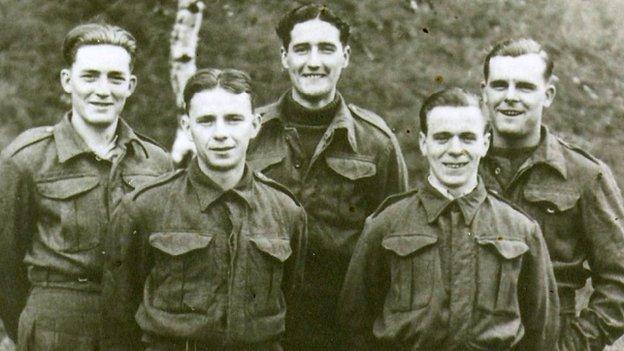
L/Cpl Saunders, far right, was held at Stalag VIIIB PoW camp near Lamsdorf
It was only when Mr Hutchinson managed to track down the records from Stalag VIIIB Lamsdorf, the PoW camp that was L/Cpl Saunders' home for the final four years of his life, that he got an idea of where his uncle was.
The records, which had been sent to the Red Cross in Geneva after the war, stated that he had been buried in Popielow. Visits to the local area unearthed local stories about two British PoWs who had been shot and buried in unmarked graves.
Mr Hutchinson deduced that one of these graves must belong to L/Cpl Saunders. Meanwhile, fellow historian John Dixon has been able to identify the second grave as that of Henry Alexander Thomson, of the Lothian and Borders Horses.
The discovery of affidavits taken by the British Army after the war, revealed both soldiers were killed by German guard Albert Martin, described by prisoners as a sallow-faced man in his 30s.

The story of L/Cpl Saunders
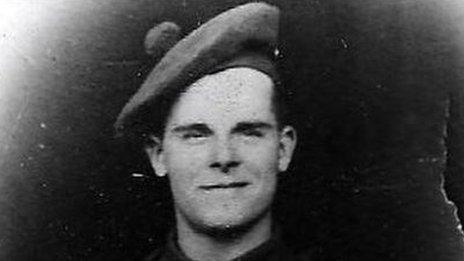
•Born 24 February, 1919, at The Batts in Bishop Auckland
•His coal miner father Joseph spent three years in the trenches in World War One before being discharged with typhoid after drinking contaminated water
•Tommy was the eldest of four children
•He worked as a tiler and slater before enlisting with the 1st Battalion Tyneside Scottish Black Watch and was soon promoted to L/Cpl, being paid two shillings a day
•He landed in France on 24 April, 1940, and was deployed near Arras to build airfields
•On 20 May, 1940, he was ambushed at Ficheux by German panzers. About 140 men from Tyneside Scottish were killed and more than 500 captured
•A postcard sent home on 10 June said: "I am healthy, prisoner of war in Germany, I will be brought to another camp, from there I can give my address"
•He was marched eastwards, ending up at Stalag VIIIB at Lamsdorf on 23 June, 1940.
•He was killed on 21 July, 1944, after a disagreement with a forester and guard

They revealed the pair were part of a three-man working party that had been marched into the forest to chop wood on 21 July, 1944.
A dispute, described in despatches as trivial, broke out between Paul Merek, the civilian running the operation, and the three prisoners.
Merek, a 40-year-old forester, disagreed with the men over whether they had worked a full shift or completed only three quarters of a day's work.
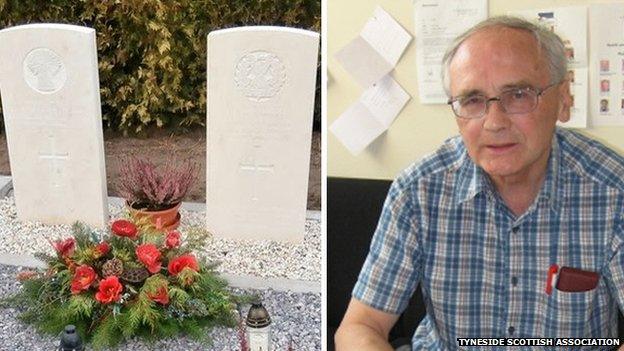
The two graves now have headstones thanks to Tom Hutchinson
The exchange became heated and Martin, who had a reputation for ill-treating prisoners - he was transferred to Lamsdorf after a "bayoneting incident" - opened fire.
Seated, L/Cpl Saunders was shot through the head while Trooper Thomson took a bullet to the chest, managing to get to his feet before collapsing and dying moments later.
As the guard aimed at the third man, the quick-thinking prisoner knocked the rifle barrel upwards and escaped unharmed.
In the prison's official records it was written that L/Cpl Saunders and Trooper Thomson were shot for rebellion, but a British commander's report of the incident said their deaths were wholly unjustified.
According to affidavits found by Mr Hutchinson, the violent incident was to be investigated as a war crime when the conflict ended. But the British forces could not find the German guard.
Mr Hutchinson said: "As the Russians moved closer to the camp it was decided to march the prisoners westwards, Martin went with them.
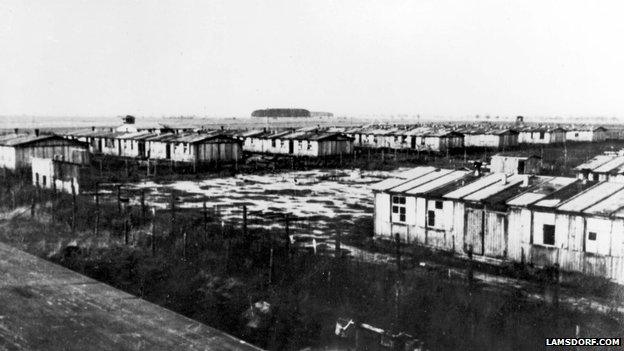
More than 100,000 prisoners passed through Lamsdorf between 1939 and 1945
"It would appear Martin got into more bother for ill treating prisoners, the upshot was he eventually got his comeuppance."
According to gunner and PoW Wilfred Farley, the German was shot and killed by other prisoners in May 1945 after developing a daily habit of kicking and striking them with his rifle butt.
About 500 prisoners died at Lamsdorf with their bodies buried locally.
Before the headstones, the only memorial marker to L/Cpl Saunders and Trooper Thompson was the inclusion of their names among the 4,506 inscribed on the Dunkirk Memorial whose final resting places were unknown.
Mr Hutchinson is now planning to write a book about the hunt for his uncle.
He said: "Having the headstone erected and officially recognised marks the end of a long search.
"To use the cliché, it draws a nice line under things."
- Published16 May 2014
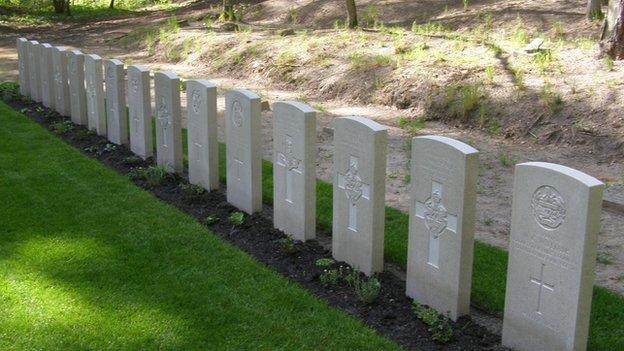
- Published4 August 2014

- Published11 August 2014
